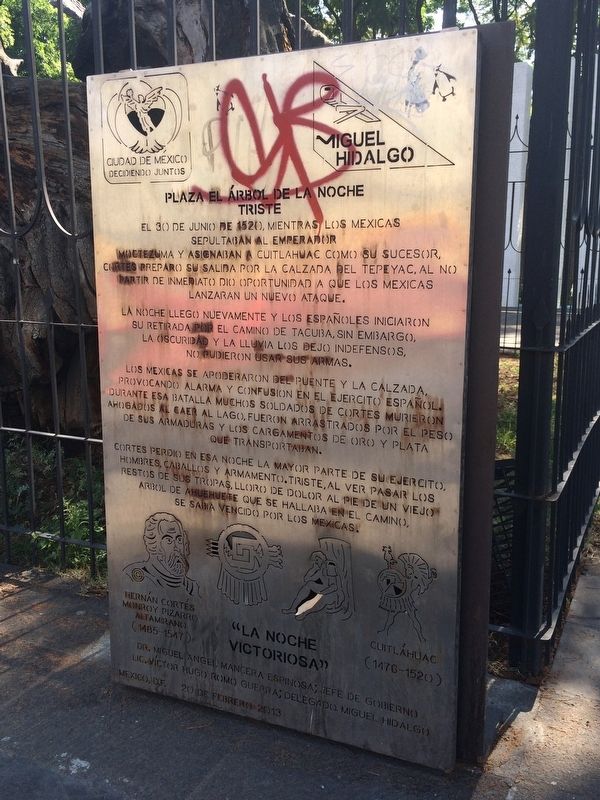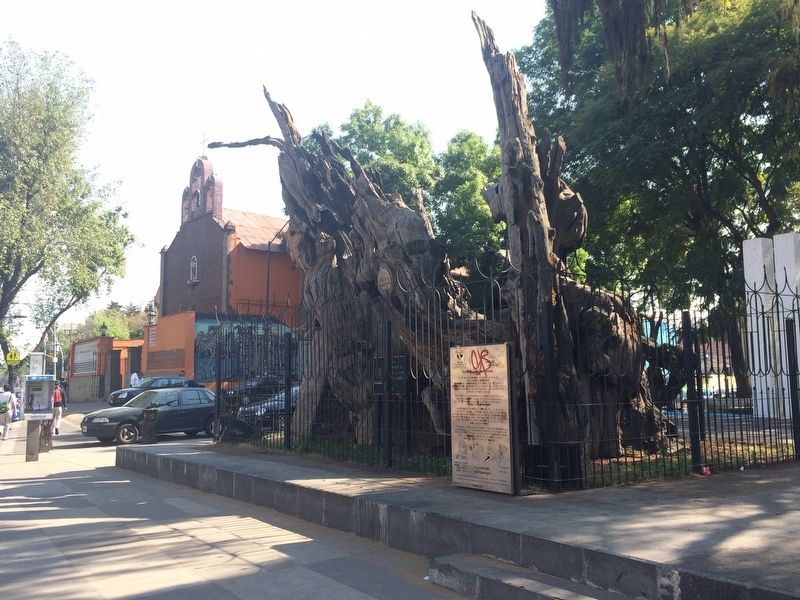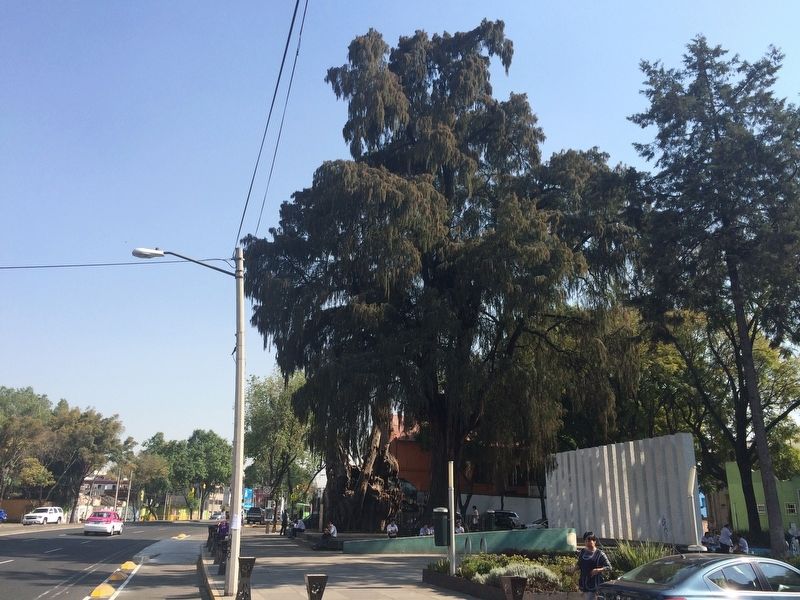Colonia Popotla in Ciudad de México, Mexico — The Valley of Mexico (The Central Highlands)
Plaza of the Tree of the Night of Sorrows
Inscription.
Plaza el Árbol de la Noche Triste
El 30 de junio de 1520, mientras los mexicas
sepultaban al Emperador
Moctezuma y asignaban a Cuitlahuac como su sucesor,
Cortes preparo su salida por la Calzada del Tepeyac, al no
partir de inmediato dio oportunidad a que los mexicas
lanzaran un nuevo ataque.
La noche llego nuevamente y los españoles iniciaron
su retirada por el Camino de Tacuba, sin embargo,
la oscuridad y la lluvia los dejo indefensos,
no pudieron usar sus armas.
Los mexicas se apoderaron del puente y la calzada,
provocando alarma y confusión en el ejercito español.
Durante esa batalla muchos soldados de Cortes murieron
ahogados al caer al lago, fueron arrastrados por el peso
de sus armaduras y los cargamentos de oro y plata
que transportaban.
Cortes perdió en esa noche la mayor parte de su ejercito,
hombres, caballos y armamento. Triste, al ver pasar los
restos de sus tropas, lloro de dolor al pie de un viejo
árbol de ahuehuete que se hallaba en el camino,
se sabia vencido por los mexicas.
Hernán Cortés Monroy Pizarro Altamirano (1485-1547)
Cuitláhuac (1476-1520)
"La Noche Victoriosa"
Dr. Miguel Angel Mancera Espinosa; Jefe de Gobierno
Lic. Víctor Hugo Romo Guerra; Delegado Miguel Hidalgo
Mexico, D.F. 20 de febrero 2013
Plaza of the Tree of the Night of Sorrows
On June 30, 1520, while the Mexicas buried the Emperor Moctezuma and assigned Cuitláhuac as his successor, Cortés prepared his departure by way of the Tepeyac Road. However, by not leaving immediately he gave the Mexicas the opportunity to launch a new attack.
It soon became night and the Spaniards had to retreat on the Tacuba Road. With the darkness and the rain they were left defenseless, and could not use their weapons to great effect.
The Mexica seized the bridge and the road, causing alarm and confusion in the Spanish army. During that battle many of Cortés' soldiers died by drowning when they fell into the lake, where they were dragged to their death by the weight of their armor and the gold and silver that they carried.
Cortés lost in one night most of his army, men, horses and armament. Sadly, as he watched the remnants of his troops pass, he wept in pain at the foot of an old ahuehuete tree on the road, and knew that he had been overcome by the Mexicas.
Hernán Cortés Monroy Pizarro Altamirano (1485-1547)
Cuitláhuac
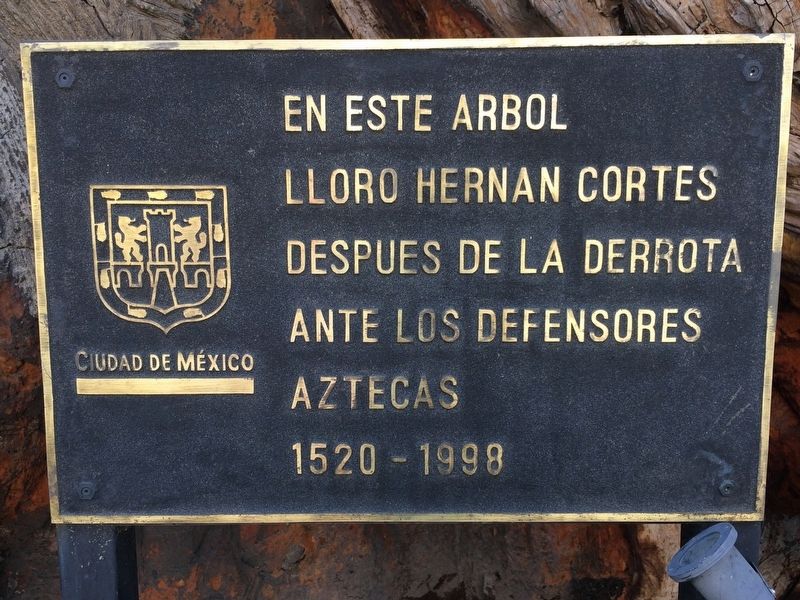
Photographed By J. Makali Bruton, January 24, 2017
2. An additional marker at the Plaza of the Tree of the Night of Sorrows
This additional marker reads:
En este árbol
lloro Hernan Cortes
después de la derrota
ante los defensores
aztecas
1520-1998
English translation:
At this tree Hernán Cortés cried after the defeat against the Aztec defenders
1520-1998
En este árbol
lloro Hernan Cortes
después de la derrota
ante los defensores
aztecas
1520-1998
English translation:
At this tree Hernán Cortés cried after the defeat against the Aztec defenders
1520-1998
"The Victorious Night"
Dr. Miguel Angel Mancera Espinosa; Head of Government
Víctor Hugo Romo Guerra; Miguel Hidalgo Delegation
Mexico, D.F., February 20, 2013
Erected 2013.
Topics and series. This historical marker is listed in this topic list: Wars, Non-US. In addition, it is included in the Historic Trees series list. A significant historical date for this entry is February 20, 2013.
Location. 19° 27.333′ N, 99° 10.754′ W. Marker is in Ciudad de México. It is in Colonia Popotla. Marker is at the intersection of Calzada México-Tacuba and Calle Mar Blanco, on the right when traveling east on Calzada México-Tacuba. Touch for map. Marker is in this post office area: Ciudad de México 11400, Mexico. Touch for directions.
Other nearby markers. At least 8 other markers are within 3 kilometers of this marker, measured as the crow flies. The American Cemetery in Mexico City (approx. 2.1 kilometers away); Francisco Díaz Covarrubias (approx. 2.5 kilometers away); Ignacio Manuel Altamirano (approx. 2.6 kilometers away); Antonio Caso (approx. 2.7 kilometers away); 400th Anniversary of the Virgin at Tepeyac (approx. 2.7 kilometers away); José Rosas Moreno (approx. 2.7 kilometers away); Guillermo Prieto (approx. 2.8 kilometers away); a different marker also named Guillermo Prieto (approx. 2.8 kilometers away). Touch for a list and map of all markers in Ciudad de México.
Regarding Plaza of the Tree of the Night of Sorrows.
The marker describes one of the most amazing sequences of the Spanish conquest of Mexico, where the Mexicas (also known as Aztecs) almost completely defeated Cortés, his Spanish troops and Tlaxcaltecan allies. As the Spanish and their allies attempted to retreat from the center of Tenochtitlán along its raised roadways, they were attacked by the Mexicas. Many fell into the lake that surrounded the Mexica capital and drowned. Although sources differ, it is estimated that half of the Spanish, or some 600 troops were killed. Likewise, some 900 of the thousand Tlaxcaltecan allies were slaughtered. As the marker also mentions, Cortés lost most of his armor and artillery, as well as most of the gold and silver that he had stolen from Moctezuma. Various sources describe Cortés crying after the battle at the base of this tree. He and the remainder of his troops would regroup and head to safety in Tlaxcala. After some time he would attack the Aztecs again, who had been severely weakened by smallpox and other diseases brought by the Spanish. After a siege, the city fell on August 13, 1521.
The tree is known in Mexico as an "ahuehuete" (Taxodium hueglii). The trunk of the original tree is still at the location, although a large portion of it was burned from vandalism in 1980.
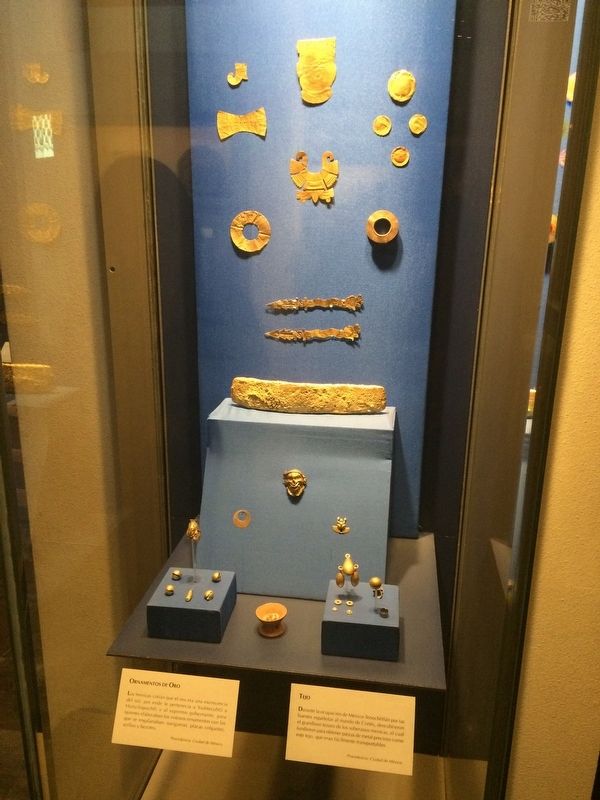
Photographed By J. Makali Bruton, January 25, 2017
5. A gold bar dropped by the Spanish on the Night of Sorrows
The gold bar shown at the center of this view was found during excavations for a new building in Mexico City. It is considered to be one of the gold bars that the Spanish made by melting down stolen Aztec gold jewelry. It is very likely that this bar, like many others, fell into the lake surrounding Tenochtitlán during the Night of Sorrows. This gold bar can be seen at the National Museum of Anthropology in Mexico City.
Credits. This page was last revised on March 20, 2023. It was originally submitted on May 17, 2017, by J. Makali Bruton of Accra, Ghana. This page has been viewed 448 times since then and 47 times this year. Photos: 1, 2, 3, 4, 5. submitted on May 17, 2017, by J. Makali Bruton of Accra, Ghana.
